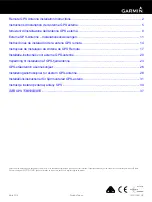
Manual Version:5PW100-20120627
3
Safety precautions
WARNING!
•
Installing antennas is dangerous. For your safety, follow the installation directions.
•
Keep the antenna away from power source, street lamps, distribution box, or other places that may
cause electrical shock.
•
Do not touch any power lines for your safety.
•
Keep safety in mind when you select your installation site. Keep the antenna away from electric
power lines and other lines.
•
Do not work alone when you install the antenna.
•
If you need to raise the mast, work with other people to avoid bodily injury.
•
Do not use a metal ladder. Do not work on a wet or windy day. Dress properly, for example, shoes
with rubber soles. Wear rubber gloves.
•
If the antenna, antenna cable, or any other installation accessory drops, get away from it to avoid
bodily injury.
•
If an accident, for example, electrical shock, occurs with the power lines, immediately call for
qualified emergency help.
Installation guidelines
Antenna can transmit and receive signals which are susceptible to obstacles and interferences. To ensure
the best possible performance of the antenna, follow these guidelines:
•
Install the antenna vertically and make sure the antenna bottom is facing downwards.
•
Keep the antenna away from metal obstructions such as heating and air-conditioning ducts. Use the
rigid cable to connect the antenna if necessary.
•
The density of the wall materials determines the number of walls signals can pass through and still
ensure data communication. Consider the following before choosing the location to install the
antenna:
{
Signals can penetrate vinyl and paper walls with little affect to signal strength.
{
Signals can penetrate one or two solid or pre-cast concrete walls with signal strength not
degraded.
{
Signals can penetrate three or four concrete walls or wood walls with signal strength not
degraded.
{
Signals can penetrate five or six drywalls or wood walls with signal strength not degraded.
{
Signals cannot penetrate a metal wall even if the metal covering is very thin.
{
Signals cannot penetrate a wire mesh spaced between 2 and 3 cm (0.79 and 1.18 in).
•
Keep the antenna away from microwave ovens and 2-GHz wireless phones, because they operate
in the same frequency range as the device to which your antenna is connected and can cause
signal interference.
























